How governments have tricked us over the Northern Territory Intervention
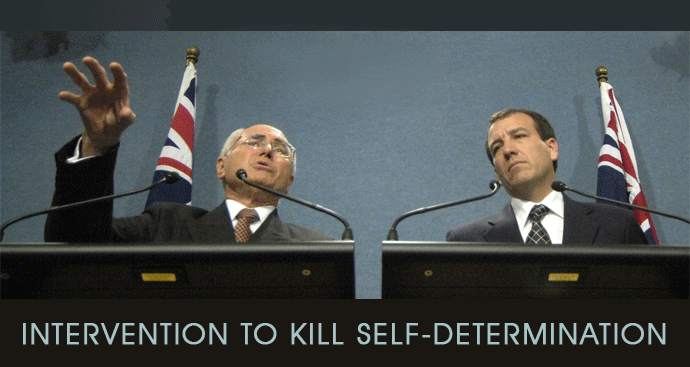
Even before the Intervention began in June 2007, government had long planned a new approach to the 'management' of Aboriginal people in the Northern Territory. It was no longer part of government thinking that self-determination and Aboriginal control over land could be allowed to continue. These were the Whitlam notions of 1975, and they were no longer acceptable.
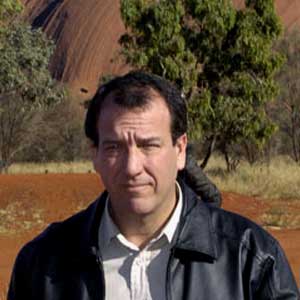
Michele Harris of 'concerned Australians'
Posted 6 July 2013
Aboriginal advocate Olga Havnen, in her Lowitja O'Donoghue oration, has asked a critical question.
She asks, what has been the psychological impact of the Intervention on Aboriginal people of the Northern Territory? It is surprising that so little attention has been given before now to this critical, yet in some ways tenuous, link.
Even before the Intervention began in June 2007, government had long planned a new approach to the 'management' of Aboriginal people in the Northern Territory. It was no longer part of government thinking that self-determination and Aboriginal control over land could be allowed to continue. These were the Whitlam notions of 1975, and they were no longer acceptable.
Early inklings of change occurred in 2004 with the management of grants being transferred from communities to government's newly established Indigenous Coordination Centres. More ominous were the Amendments of 2006 to the Aboriginal Land Rights Act and the memoranda of agreements that followed. Government had made it clear that it wished to re-engage itself directly in the control of community land through leasing options, as well as to open up Aboriginal land for development and mining purposes.
The plan was to empty the homelands. This has not changed. However, it was recognised that achieving this would be politically fraught = it would need to be accomplished in a manner that would not off-side mainstream Australia. Removing Aboriginal people from their land and taking control over their communities would need to be presented in a way that Australians would believe to be to Aboriginal advantage, whatever the tactics.
So began the campaign to discredit the people and to stigmatise Aboriginal men of the Northern Territory publicly. It would be the Minister himself who would take centre stage. It seemed that all Aboriginal men were engaged in paedophilia. The Minister readily gave television and radio interviews, declaring that he knew there were paedophile rings in every Aboriginal community. Viewers were asked during their evening news broadcasts how they felt about Aboriginal children going to bed at night knowing they were not safe.
This was a government Minister engaging in a sensationalist campaign aimed at demoralising Aboriginal men, and was probably the lowest point in any government behaviour ever seen in Australia's political history. When challenged by the NT Chief Minister to name the people involved, the situation deteriorated further.
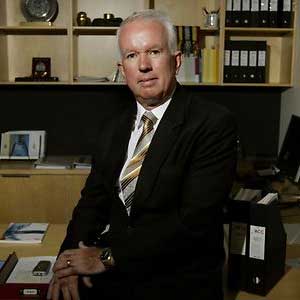
With the collusion of the ABC, a senior executive service bureaucrat from the Minister's own office posed as a youth worker from Mutitjulu, a place he had never visited, and collaborated with the Minister's story.
There could have been nothing more sordid. Even in 2009, when the CEO of the Australian Crime Commission, John Lawler, reported that his investigation had shown there were no organised paedophile rings operating in the NT, no formal apology was ever made to the Aboriginal men and their families who were brutally shamed by the false claims.
Beyond this, the Australian system appeared to have no way by which it could confront the former Minister for the incredible harm done by his persistent inflammatory public statements which had given rise to negative stereotyping of an ethnic group. The Minister had done his job. The Australian people had been suitably shocked, and the Intervention was seen as a necessary consequence. Furthermore, the Labor Party, which had seemingly feigned horror at the 2006 amendments to the Aboriginal Land Rights Act, would now eagerly provide bi-partisan support.
What was the psychological impact of publicly shaming Aboriginal men for repulsive and unacceptable behaviours in which hadn't engaged? It undermined their feelings of self-worth and marginalised them. It was a direct attack on their identity. The fact that they had no way of defending themselves simply led to a state of despair. One's sense of safety is bound uncompromisingly to a belief in justice. When that belief collapses, fear of the unknown takes over.
In many ways, the Intervention in all its forms has been an attack on Aboriginal identity, and continues to be so. Just as the focus on paedophile rings collectively impaled all Aboriginal men to gross and disgusting acts with innocent children who needed to be protected, so did the Intervention target all communities with tales of alcohol dependence, gambling, pornography use, inefficient management, money waste, poorly-maintained homes, overcrowding, and poor health.
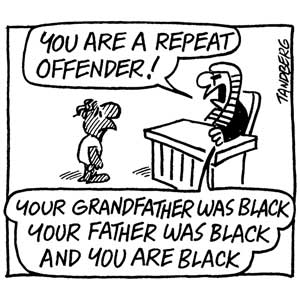
Once again, stigmatising of the people was as one, promoting aspects of dysfunction without providing background or explanation of situations, and ensuring the most sensationalised elements of disadvantage were promoted. Measures imposed were not targeted at areas of need, but were simply imposed on all as blanket measures. The oppressive restrictions were imposed on communities irrespective of whether they were perceived to be wellmanaged and achieving their goals, or whether they were struggling and in need of help. They were punished without distinction. Their individual worth was of no consequence. The intention of such measures had never been designed to assist in specific circumstances involving particular individuals or communities, but as a means of taking back control from all.
People struggled to understand why they were being targeted, why they were being punished. They were fearful for many reasons, but most especially because of the manner in which the Army had been engaged in a display to 'shock and awe'. How could the so-called 'Emergency Response' be explained? We know from stories at the time that many grabbed their children and ran to hide in the bush in the belief that once again their children would be removed from them. Why was this cruel re-traumatising of so many allowed to happen?
Government claimed the 'emergency' was required to protect children from sexual abuse. While very serious concerns regarding child sexual abuse had been raised through the 'Little Children are Sacred' Report, the statistics showed its rate was far far lower than in the state of New South Wales. The complex legislation that had been prepared to implement the Northern Territory Emergency Response had commenced long before the release of the report, and none of it was directly aimed at the protection of young children.
Re-traumatisation has done plenty of damage. If ever there had been a growing sense of trust between Aboriginal people and the dominant race, it was blown away in 2007. The trust was gone, and the fear returned. The very manner in which the Intervention was rolled-out ensured increased confusion and disorientation, more like an act of counter-insurgence. Normal channels of engagement and communication were ignored. Elders became invisible; they were neither consulted nor invited to comment. Government business managers were installed to make decisions in communities. Responsibilities of Elders were removed from them. Controls set up to keep many communities 'dry' were dismantled, and responsibility for alcohol control transferred to government.
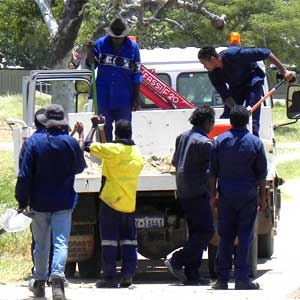
Whether a person was in debt or held a weighty savings account, they were forced to receive half their welfare payment through a plastic card which could be used only at certain shops. Capacity to manage money was irrelevant. Card-holders were shamed by having to stand in a separate supermarket queue.
With the demise of CDEP, the Community Development Employment Projects, those who had been employed, often for many years, found themselves on unemployment benefits. They watched on as Shire offices sent in contract workers to take over many of the tasks previously managed by the local workforce. Community council offices were closed down and stripped of all equipment. Bank accounts were frozen, and responsibilities transferred from local community staff to those in Shire offices often many hundreds of kilometres away.
Community programs, often designed and developed by local people, gradually ground to a halt. Small communities were devastated. The disempowerment was unimaginable, and only served to exacerbate the aimless and bewildered movements away from the security of community land towards the urban centres that offered no guarantees of shelter or protection from the social dysfunction of those who were already lost.
What was the psychological impact on Aboriginal people? Though little or no research has been conducted on the current situation, we do know enough from earlier studies to recognise that great psychological harm has resulted from the imposition of such targeted social oppression.
The sudden and brutal upheaval of the Intervention and the manner in which it was perpetrated left people in a state of helplessness. It was the unpredictability of their environment which left them bereft of any natural coping skills. They had lost all ability to predict what might happen next. Anxiety levels were high, and distress dominated. The demands were so relentless that any chance of adapting behaviours to deal with new circumstances was overtaken by new waves of oppressive change.

Rosalie Kunoth-Monks, Elder from Utopia
Those elements central to Aboriginal culture were all under attack = language, law and land. Federal and Territory governments joined in their assault. Bilingual learning programs were banned from schools. Clearly discriminatory was the exclusion of any consideration of Aboriginal customary law by judges and magistrates when deliberating on bail and sentencing. It degraded and devalued Aboriginal culture, and, again, there seemed to be determined disrespect for the culture itself. A fear of dispossession was reinforced by the 2006 amendments to the Aboriginal Land Rights Act, whereby control over community township lands was transferred from Aboriginal Land Councils to a government statutory body. Without discussion, this opened up the possibility for sub-leases on community owned land.
"Take away from me my language, take away from me my responsibilities for the land, take away from me my land, and I am nothing"
- Rosalie Kunoth-Monks
Further reinforced was the declared intention of emptying the homeland areas through a Memorandum of Agreement between Federal and Territory governments that no new housing would appear on homelands or outstations (September 2007). The changes added to the sense of overwhelming fear and uncertainty. As Rosalie Kunoth-Monks, Elder from Utopia, said, "take away from me my language, take away from me my responsibilities for the land, take away from me my land, and I am nothing". This, then, was the impact of the Intervention.
During a visit to Melbourne last year, Rosalie spoke about the trauma with which her people live. She talked about their loss of security. It is inevitable that a large percentage of Aboriginal people who have lived through the extraordinary turmoil of the last six years in the Territory have been traumatised by their experiences. That loss of security results from long periods being overwhelmed by a sense of fear, a sense of constant danger, and always on the alert. This denies a person any real sense of relaxation. Being constantly agitated impacts on relationships and trust. Stress levels are high. Others suffer by the constant intrusions of panic and anxiety over which they have no control. A general loss of self-esteem easily deteriorates into depression and despair.
It is known that the emotional development of children who have been exposed to constant stress and trauma is often affected. Adolescents may have difficulty expressing their emotion, and have difficulty relating to others. For the reasons already discussed, it can affect their concentration, their retention of information, and their ability to learn. Children are ever aware of trauma on those closest to them threatening the fragile framework of care upon which they rely.
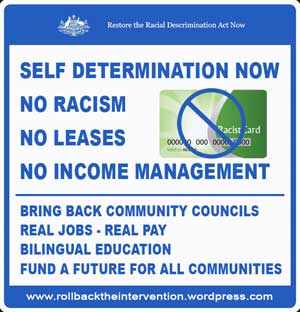
The deterioration of the psychological health of Aboriginal people of the Northern Territory has been screaming from the pages of every Closing the Gap report since its inception in 2009. Consistently, the reports have shown rising rates of self-harm, domestic violence, and incarceration. The recorded incidence of attempted self-harm since the introduction of the Intervention has more than tripled. According to the Australian Human Rights Commission, the actual rate of youth suicide in the NT has increased by 160%. Incidents of recorded domestic violence have doubled, and Aboriginal incarceration under the Intervention has also nearly doubled, from 688 people in March 2007 to 1311 in 2013.
As Rosalie Kunoth-Monks pointed out in 2009: "Health is about being emotionally sound, mentally sound, knowing who you are, as well as being physically fit". The notion of total despair was well described during the 2012 Senate Inquiry by Dr Djiniyini Gondarra who stated: "When our lives are being threatened and taken away, we just sit and do nothing. I have already emphasised that people are dying, not just dying spiritually and emotionally, but dying physically. They cannot live for the day because their lives are controlled by somebody else. They have given up hope: what is the use?".
Punitive measures designed in Canberra ignore the cultural realities upon the ground. As far as is possible, they simply ignore culture altogether, and hope that, by appealing to youth, the attractions of Western culture will overcome the call of repressed and aging Elders. Aboriginal culture is simply a hindrance. It is dispensable.
So where is the reality? Closing the Gap is based on the belief that if Aboriginal people live longer they will be better off. Surely, the question has to be asked, if they live longer will they be happier? And, conversely, can they live longer if they are not happy? As we have seen from the above, there is little evidence of improvements to happiness. In fact, the evidence shows the reverse. We are, in fact, drowning in a constant collection of data in the hope of measuring increased wellbeing, but we are seemingly oblivious to the operational framework on the ground that increasingly removes control and reduces the chance of the very improvements we seek.
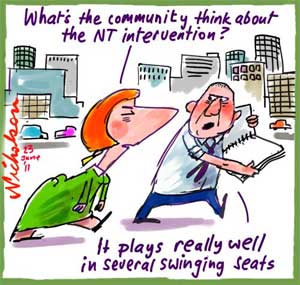
Over many years, there have been numerous reports and enquiries focusing on Aboriginal health improvements, and recommendations; they have all-but mirrored each other. For instance, we know that, for health to improve, people must have increased control over their life. Why, then, has the Intervention been designed specifically to remove control from the people? We know that stress causes incredible harm to a person's physical and psychological health. Why, then, has the Intervention been introduced without community consultation, and in a manner aimed at confusing, disorientating, and undermining Aboriginal self-worth? Why have Aboriginal lives been targeted by cruel and vicious innuendo? Why has culture been all-but ignored, since it represents the meaning and value of Aboriginal existence? By disempowerment and the very creation of trauma, incredible harm has been done.
Yes, it should be clear to everyone that the Intervention was never designed with the slightest consideration of improvement to Aboriginal health. Nor was it designed around any aspect of Aboriginal advancement. The stark reality is that its focus was to regain ultimate control over Northern Territory land and development. What we have been watching since June 2007, with the support of both major Parties, is the imposition of coercive tactics aimed at removing peoples from their homelands, and that is still the case.
Aboriginal people have lost their rights to consent and control over the very factors which directly affect their lives. Their rights have been whittled away by changes to legislation and dishonest notions of consultation. The right to self-determination has been highjacked. Forced assimilation is currently seen by government as the only way forward.
While many good people struggle to address the broad and negative impacts of the Northern Territory legislation by focusing on the need to improve the basic social determinants that surround the Intervention measures, there remains a certain reluctance to address the central issue of the right to Indigenous integrity. This is the right of Indigenous peoples to determine a future for themselves, the right to their culture, and the right to live on their land. Integrity has to be the beginning point, because without it there is nothing sustainable upon which to build. Gough Whitlam knew this, and we do too. It is important that we are not drawn into the illusion that there are intended links between the oppressive intentions of the Intervention and the genuine concerns for the future of Aboriginal peoples.
For Australia, the Intervention has simply been one more step backwards into the mire of dispossession and dishonesty. So captivated have our leaders become by the lure of development and gain that delusion has convinced them that the benefits to Aboriginal people of such plunder will far outweigh the loss of control over their lives. This is perhaps one of the fault lines, to which Olga Havnen made reference in her oration, as being in need of attention. What would it take for a new government to find the courage to realign itself with Aboriginal integrity, justice, and equality? Nelson Mandela advised of the need for a collective voice.
That would include you and me.
"Our lives begin to end the day we become silent about things that matter." Martin Luther King Jr~

